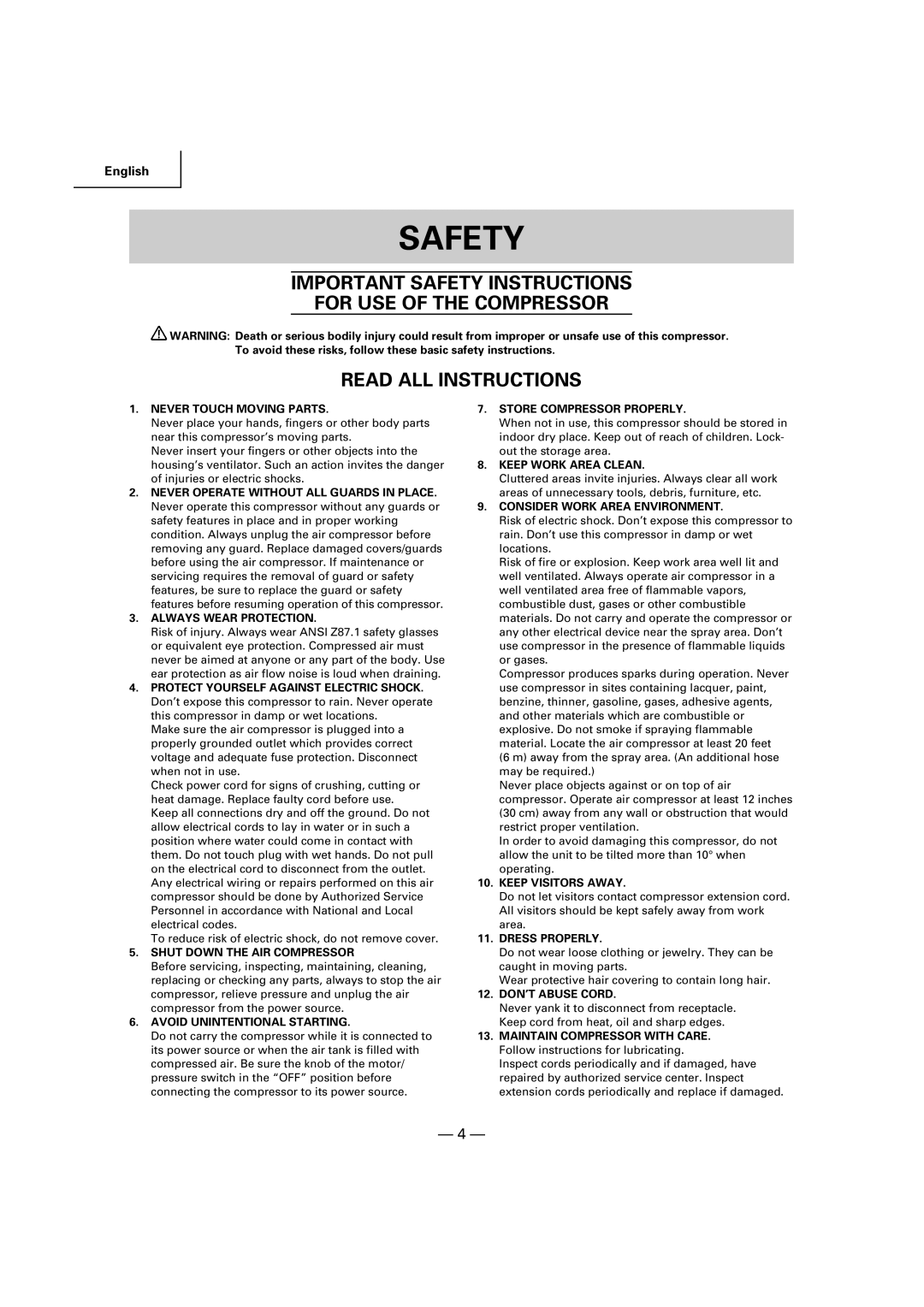
English
SAFETY
IMPORTANT SAFETY INSTRUCTIONS
FOR USE OF THE COMPRESSOR
![]() WARNING: Death or serious bodily injury could result from improper or unsafe use of this compressor. To avoid these risks, follow these basic safety instructions.
WARNING: Death or serious bodily injury could result from improper or unsafe use of this compressor. To avoid these risks, follow these basic safety instructions.
READ ALL INSTRUCTIONS
1.NEVER TOUCH MOVING PARTS.
Never place your hands, fingers or other body parts near this compressor’s moving parts.
Never insert your fingers or other objects into the housing’s ventilator. Such an action invites the danger of injuries or electric shocks.
2.NEVER OPERATE WITHOUT ALL GUARDS IN PLACE. Never operate this compressor without any guards or safety features in place and in proper working condition. Always unplug the air compressor before removing any guard. Replace damaged covers/guards before using the air compressor. If maintenance or servicing requires the removal of guard or safety features, be sure to replace the guard or safety features before resuming operation of this compressor.
3.ALWAYS WEAR PROTECTION.
Risk of injury. Always wear ANSI Z87.1 safety glasses or equivalent eye protection. Compressed air must never be aimed at anyone or any part of the body. Use ear protection as air flow noise is loud when draining.
4.PROTECT YOURSELF AGAINST ELECTRIC SHOCK. Don’t expose this compressor to rain. Never operate this compressor in damp or wet locations.
Make sure the air compressor is plugged into a properly grounded outlet which provides correct voltage and adequate fuse protection. Disconnect when not in use.
Check power cord for signs of crushing, cutting or heat damage. Replace faulty cord before use.
Keep all connections dry and off the ground. Do not allow electrical cords to lay in water or in such a position where water could come in contact with them. Do not touch plug with wet hands. Do not pull on the electrical cord to disconnect from the outlet. Any electrical wiring or repairs performed on this air compressor should be done by Authorized Service Personnel in accordance with National and Local electrical codes.
To reduce risk of electric shock, do not remove cover.
5.SHUT DOWN THE AIR COMPRESSOR
Before servicing, inspecting, maintaining, cleaning, replacing or checking any parts, always to stop the air compressor, relieve pressure and unplug the air compressor from the power source.
6.AVOID UNINTENTIONAL STARTING.
Do not carry the compressor while it is connected to its power source or when the air tank is filled with compressed air. Be sure the knob of the motor/ pressure switch in the “OFF” position before connecting the compressor to its power source.
7.STORE COMPRESSOR PROPERLY.
When not in use, this compressor should be stored in indoor dry place. Keep out of reach of children. Lock- out the storage area.
8.KEEP WORK AREA CLEAN.
Cluttered areas invite injuries. Always clear all work areas of unnecessary tools, debris, furniture, etc.
9.CONSIDER WORK AREA ENVIRONMENT.
Risk of electric shock. Don’t expose this compressor to rain. Don’t use this compressor in damp or wet locations.
Risk of fire or explosion. Keep work area well lit and well ventilated. Always operate air compressor in a well ventilated area free of flammable vapors, combustible dust, gases or other combustible materials. Do not carry and operate the compressor or any other electrical device near the spray area. Don’t use compressor in the presence of flammable liquids or gases.
Compressor produces sparks during operation. Never use compressor in sites containing lacquer, paint, benzine, thinner, gasoline, gases, adhesive agents, and other materials which are combustible or explosive. Do not smoke if spraying flammable material. Locate the air compressor at least 20 feet (6 m) away from the spray area. (An additional hose may be required.)
Never place objects against or on top of air compressor. Operate air compressor at least 12 inches (30 cm) away from any wall or obstruction that would restrict proper ventilation.
In order to avoid damaging this compressor, do not allow the unit to be tilted more than 10° when operating.
10.KEEP VISITORS AWAY.
Do not let visitors contact compressor extension cord. All visitors should be kept safely away from work area.
11.DRESS PROPERLY.
Do not wear loose clothing or jewelry. They can be caught in moving parts.
Wear protective hair covering to contain long hair.
12.DON’T ABUSE CORD.
Never yank it to disconnect from receptacle. Keep cord from heat, oil and sharp edges.
13.MAINTAIN COMPRESSOR WITH CARE. Follow instructions for lubricating.
Inspect cords periodically and if damaged, have repaired by authorized service center. Inspect extension cords periodically and replace if damaged.
— 4 —
